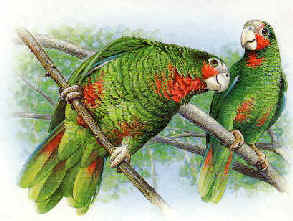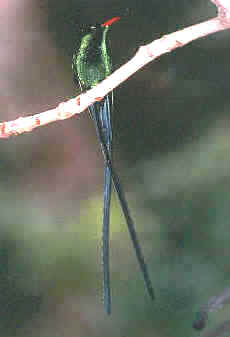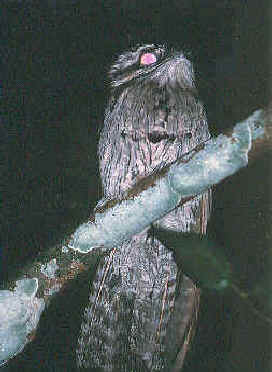
E-mail: font@focusonnature.com
Phone: Toll-free in USA 1-800-721-9986
or 302/529-1876; Fax: 302/529-1085
 |
PO Box 9021,
Wilmington, DE 19809, USA E-mail: font@focusonnature.com Phone: Toll-free in USA 1-800-721-9986 or 302/529-1876; Fax: 302/529-1085 |
THE
FOCUS ON NATURE TOUR IN THE CAYMAN ISLANDS and JAMAICA
February/March 2006

The Rose-throated, or
Cayman, Amazon
Links:
List of Birds during our Cayman Islands & Jamaica - February/March '06
Cumulative list of Birds during FONT Cayman Island Tours
Cumulative list of birds during FONT Jamaica Tours
List of Birds during FONT tours in the West Indies (with photos)
Upcoming
FONT Birding & Nature Tours in the Caribbean
home
The following account written by Armas Hill, leader
of the tours:
Our 2006 tours in the Caymans
(Feb 23-26)
and Jamaica (Feb 27-Mar
4), were done either individually or in
combination. During those tours, in both the Caymans and Jamaica, there were some
fine highlights among the 135 species of birds collectively
seen.
In the Caymans, one beautiful morning as we walked the trails of the botanical
garden, there was the rich melodious song of "Sweet Bridget". That's
the local name for the Yucatan Vireo, a species that occurs in the Caribbean
only on Grand Cayman Island. Other birds that we saw during the walk that
morning included the Rose-throated (or Cayman) Amazon, Mangrove Cuckoo,
LaSagra's Flycatcher, Loggerhead Kingbird, another Vireo, the Thick-billed, and
the attractive Western Spindalis - the last of these was at one time known as
the Stripe-headed Tanager. That species has now been "split" into 4 -
the Western Spindalis occurs also in the Bahamas, Cuba, and Cozumel Island, off
Mexico. All of the nice birds just-mentioned were in addition to others that
were common including Bananaquits and various warblers. Most of the warbler
species had migrated from the north, but the Vitelline and the Golden Warblers
were residents. The Vitelline Warbler only occurs in the Caymans, and one other
small Caribbean island - Swan Island, to the
south.
The Northern Mockingbirds on the Cayman Islands are a resident subspecies, not
as "northern" as those in North America. In the Caymans, it's called
the "Nightingale". It sings & sings (day & night), and has a
repertoire of songs it has learned from other birds.
Another notable landbird we saw on Grand Cayman Island was the endemic
subspecies of the Cuban Bullfinch. Otherwise, that bird occurs in Cuba.
There's a distinctive, and endemic, race of the Northern Flicker on Grand Cayman
Island. And another woodpecker there is also a subspecies endemic to the island,
the local race of the West West Indian Woodpecker, that also resides in Cuba and the
Bahamas.
Most places in the Caribbean the West Indian Whistling-Duck is rather rare and a
bit hard to find. Not so in the Caymans. On Grand Cayman, we saw them at a few
spots. At one, there were well over a hundred.
A large number of Red-footed Boobies breed on Little Cayman Island. Over a
couple thousand are in the colony there, with birds of both color morphs - brown
and white. Many Magnificent Frigatebirds also nest in that colony. It was fun
watching both species. Many of the male frigatebirds had large inflated red
throat-sacs. That colony of Red-footed Boobies, by the way, is the largest, it's
said not just in the Caribbean, but also in the Americas. Assuming that to be
true, it's either the largest, or one of the largest, in the
world.
As far as islands go, in the world, Little Cayman is far from large. With just a
handful of people, that small island is such a pristine place - and a favorite
of haunt of wintering warblers, who share the place with resident birds that
include Caribbean Elaenia and a rare subspecies of the Greater
Antillean
Grackle.
Quite different from Little Cayman Island is another Caribbean island, much
larger and often lush and green. I'm referring now to Jamaica, where during our
tour following the Caymans, we saw about 120 species of birds, including nearly
all of the over 20 endemics.
Some of our avian highlights of Jamaica were birds not among the endemics, but
highlights none the less. There was a fine look at a Yellow-breasted Crake. And
there was close-up twosome of male and female Masked Ducks.
From atop a cliff, we looked down upon White-tailed Tropicbirds gyrating in
flight. Not only wre their tails white; they were long. In all, about 20
White-tailed Tropicbirds were flying about by that cliff that morning.
Among the endemic birds of Jamaica, there's a becard (the only species of
becard
in the Caribbean), and two species of cuckoos (one, the Chestnut-bellied, called
the "Old Man Bird"; the other, the Jamaican Lizard-Cuckoo, called the
"Old Woman Bird". There are 2 endemic species of thrushes, one the
White-eyed, the other the White-chinned. And there are 2 endemic species of
parrots, the Yellow-billed and the Black-billed.)
Among the favorite of the endemics, are 2 hummingbirds known locally as
"Doctorbirds".
They are the Streamertails (the males with very long, black tails). In most of
Jamaica, the Red-billed Streamertails reside. Locally, in the lush northeast
corner of the island, there's the Black-billed Streamertail. We saw one of the
latter sitting on its nest. Some of the former fed from our hands, at a renowned
birding locale that's been near Montego Bay over 50 years, a place called "Rocklands".
For all those many years, hummingbirds have tamely been feeding there. All one
needs to do is sit on a chair, and hold a small tube of sugar water in one hand,
as the little feet of the hummingbird perches on a finger of the other hand.
Quite a
treat!
Also a treat in that area, was the observation of a roosting Jamaican Potoo
during the day. When it yawned, the red inside of its mouth could be seen. Later
we saw a potoo when they're more active, after dark. It, too, perched for us, on
a roadside post outside our van.
One of the most enjoyable sounds of our Jamaica stay was heard a couple hours
earlier that day - from a bird noted in the book as the Jamaican Crow, but
called by the Jamaicans the "Jabbering Crow". Jabber it
does.
And so, again, in 2006, we had good birding, and good times, in the Caribbean,
in the Caymans and Jamaica. The tours were the 5th for us in the Caymans, and
the 10th in Jamaica. We look forward to going back to both
again.

A Red-billed Streamertail
photographed during a FONT tour in Jamaica.

A Jamaican Potoo,
or as its known in Jamaica, the "Pa-too".
This photograph was also taken
during a FONT Jamaica Tour.